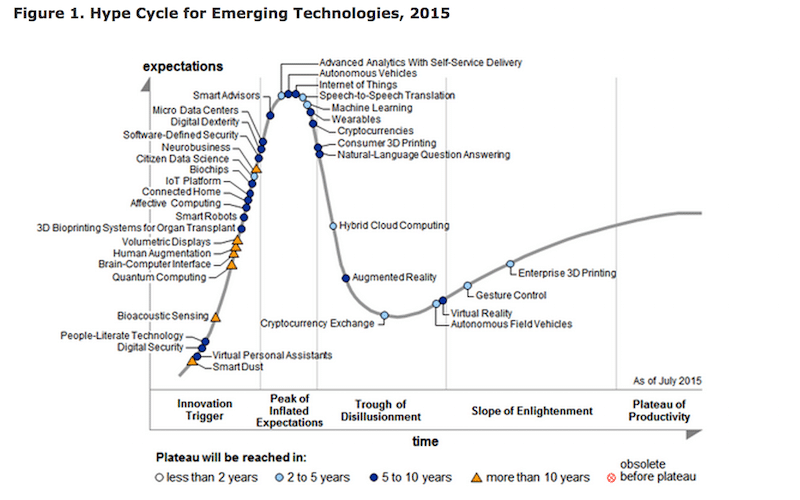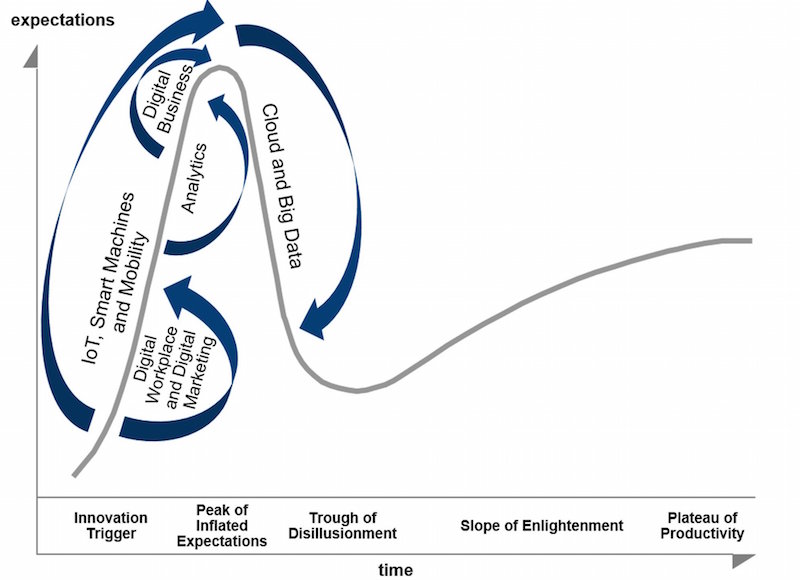This month Gartner released the 2015 Hype Cycle of Emerging Technologies, which helps enterprises identify which emerging computing technologies, services and disciplines to invest in.
“It expresses why we’re hearing hype in the industry about some area, it helps you understand where the noise is happening”, says Gartner vice-president and analyst Betsy Burton. “But it’s really important that people don’t consider a position on the hype cycle, as an indication of maturity”.

In recent years of releasing its hype cycle report, Gartner has complemented the hype cycle curve with a maturity rating. Paired together, the indicators can give a business an idea if a technology is right for them to consider adopting.
Major changes in the 2015 report include the placement of autonomous vehicles, which have shifted from pre-peak to peak of the Hype Cycle. While the autonomous vehicle industry is still emerging, this movement still represents a significant advancement, with all major automotive companies placing autonomous vehicles in their near-term strategies.
Similarly, the growing momentum (from post-trigger to pre-peak) in smart building solutions has introduced entirely new solutions and platforms enabled by new technology providers and existing manufacturers.
Looking at this from a smart building perspective, and taking note of the increasingly blurred lines between home and office, office and hospitality, hospitality and recreational venues in the urban environment, we might well assume that the question of "fad or trend?" may be the wrong question.

For example, at the peak of inflated expectations just two years ago, Big Data was dethroned by the Internet of Things (IoT) last year, but it was still estimated to be five to 10 years from the “Plateau of Productivity”, only to completely disappear from Gartner’s hype radar this year. While the Internet of Things (IoT) is still at the top of the list, along with self-driving cars (“autonomous vehicles”) ascending from pre-peak to the peak of the hype cycle.
The trend for the broad Internet of Things is clear and certain; people's demand for technology to play a role in both basic human needs, work and in various recreational activities, is here to stay. In the smart buildings arena for example Memoori has been closely following the Transformation of Building Automation Systems into the Building Internet of Things or “BIoT”.
In their 2015 report Gartner has distilled the 2,100 technologies, services and disciplines it looked at into “megatrends”. “The Internet of Things (IoT), smart machines and mobility form a set of interrelated disciplines that will soon be of huge importance to business. They will drive efficiencies, unveil growth opportunities, and create new experiences for customers and constituents. They are among the pillars of digital business, creating new business designs by blurring the physical and digital worlds” the report states.
“Mobility, IoT and digital business are creating a massive interest in analytics technologies and disciplines. Meanwhile, enterprises recognize the true capabilities of cloud computing, especially in the areas of software as a service and cloud office” it continues.
The graph infers that the Internet of Things, wearables and driverless cars are currently overhyped in the technology market, which could soon lead to disillusionment with what the technologies can actually achieve.
The real challenge for companies who provide people the services for smart buildings and smart cities, is coming up with disciplined and pragmatic resource planning, then securing and allocating investment of money, and time, to ensure that hype becomes reality.
[contact-form-7 id="3204" title="memoori-newsletter"]



